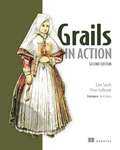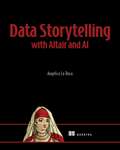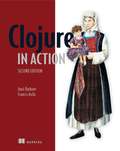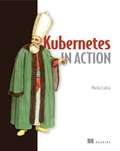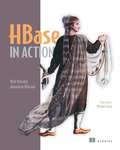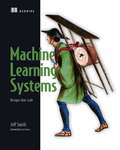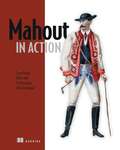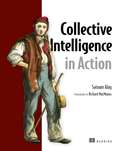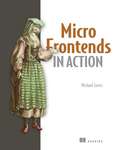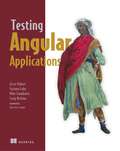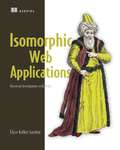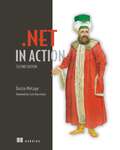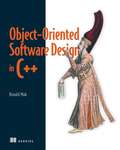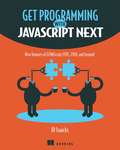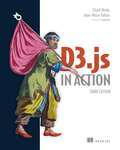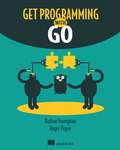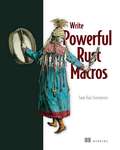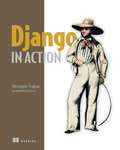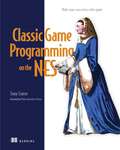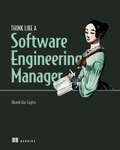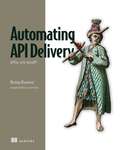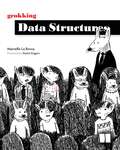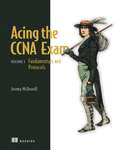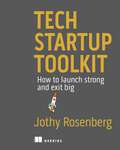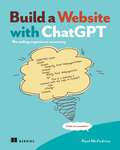- Table View
- List View
Grails in Action
by Glen Smith Peter LedbrookSummaryGrails in Action, Second Edition is a comprehensive introduction to Grails 2 focused on making you super-productive fast. In this totally revised new edition, you'll master Grails 2.3 core skills as you apply TDD techniques to developing a full-scale Twitter clone. Along the way you'll learn the latest single-page web app UI techniques, work with NoSQL backends, integrate with enterprise messaging, and implement a complete RESTful API for your services. Purchase of the print book includes a free eBook in PDF, Kindle, and ePub formats from Manning Publications.About the TechnologyIt may be time for you to stop reconfiguring, rewriting, and recompiling your Java web apps. Grails, a Groovy-powered web framework, hides all that busy work so you can concentrate on what your applications do, not how they're built. In addition to its famously intuitive dev environment and seamless integration with Spring and Hibernate, the new Grails 2.3 adds improved REST support, better protection against attacks from the web, and better dependency resolution.About the BookGrails in Action, Second Edition is a comprehensive introduction to Grails 2. In this totally revised edition you'll master Grails as you apply TDD techniques to a full-scale example (a Twitter clone). Along the way you'll learn single-page web app techniques, work with NoSQL back ends, integrate with enterprise messaging, implement a RESTful API ... and more.No Java or Groovy knowledge is required. Some web development and OOP experience is helpful.What's InsideCovers Grails 2.3 from the ground upAgile delivery and testing using SpockHow to use and manage pluginsTips and tricks from the trenchesAbout the AuthorsThere's no substitute for experience: Glen Smith and Peter Ledbrook have been fixtures in the Grails community, contributing code, blogging, and speaking at conferences worldwide, since Grails 0.2.Table of ContentsPART 1 INTRODUCING GRAILSGrails in a hurryThe Groovy essentialsPART 2 CORE GRAILSModeling the domain 63Creating the initial UIRetrieving the data you needControlling application flowServices and data bindingDeveloping tasty forms, views, and layoutsPART 3 EVERYDAY GRAILSBuilding reliable applicationsUsing plugins: just add waterProtecting your applicationExposing your app to other programsSingle-page web applications (and other UI stuff) Understanding Spring and transactionsPART 4 ADVANCED GRAILSUnderstanding events, messaging, and scheduling NoSQL and GrailsBeyond compile, test, runGrails in the cloudBONUS ONLINE CHAPTERSAdvanced GORM kung fuDeveloping plugins
Data Storytelling with Altair and AI
by Angelica Lo DucaGreat data presentations tell a story. Learn how to organize, visualize, and present data using Python, generative AI, and the cutting-edge Altair data visualization toolkit.Take the fast track to amazing data presentations! Data Storytelling with Altair and AI introduces a stack of useful tools and tried-and-tested methodologies that will rapidly increase your productivity, streamline the visualization process, and leave your audience inspired. In Data Storytelling with Altair and AI you&’ll discover: • Using Python Altair for data visualization • Using Generative AI tools for data storytelling • The main concepts of data storytelling • Building data stories with the DIKW pyramid approach • Transforming raw data into a data story Data Storytelling with Altair and AI teaches you how to turn raw data into effective, insightful data stories. You&’ll learn exactly what goes into an effective data story, then combine your Python data skills with the Altair library and AI tools to rapidly create amazing visualizations. Your bosses and decision-makers will love your new presentations—and you&’ll love how quick Generative AI makes the whole process! About the technology Every dataset tells a story. After you&’ve cleaned, crunched, and organized the raw data, it&’s your job to share its story in a way that connects with your audience. Python&’s Altair data visualization library, combined with generative AI tools like Copilot and ChatGPT, provide an amazing toolbox for transforming numbers, code, text, and graphics into intuitive data presentations. About the book Data Storytelling with Altair and AI teaches you how to build enhanced data visualizations using these tools. The book uses hands-on examples to build powerful narratives that can inform, inspire, and motivate. It covers the Altair data visualization library, along with AI techniques like generating text with ChatGPT, creating images with DALL-E, and Python coding with Copilot. You&’ll learn by practicing with each interesting data story, from tourist arrivals in Portugal to population growth in the USA to fake news, salmon aquaculture, and more. What's inside • The Data-Information-Knowledge-Wisdom (DIKW) pyramid • Publish data stories using Streamlit, Tableau, and Comet • Vega and Vega-Lite visualization grammar About the reader For data analysts and data scientists experienced with Python. No previous knowledge of Altair or Generative AI required. About the author Angelica Lo Duca is a researcher at the Institute of Informatics and Telematics of the National Research Council, Italy. The technical editor on this book was Ninoslav Cerkez. Table of Contents PART 1 1 Introducing data storytelling 2 Running your first data story in Altair and GitHub Copilot 3 Reviewing the basic concepts of Altair 4 Generative AI tools for data storytelling PART 2 5 Crafting a data story using the DIKW pyramid 6 From data to information: Extracting insights 7 From information to knowledge: Building textual context 8 From information to knowledge: Building the visual context 9 From knowledge to wisdom: Adding next steps PART 3 10 Common issues while using generative AI 11 Publishing the data story A Technical requirements B Python pandas DataFrameC Other chart types
Clojure in Action
by Amit RathoreSummaryA fully revised edition that covers the new features available in Clojure 1.6.Purchase of the print book includes a free eBook in PDF, Kindle, and ePub formats from Manning Publications.About the TechnologyClojure is a modern Lisp for the JVM. It has the strengths you expect: first-class functions, macros, and Lisp's clean programming style. It supports functional programming, making it ideal for concurrent programming and for creating domain-specific languages. Clojure lets you solve harder problems, make faster changes, and end up with a smaller code base. It's no wonder that there are so many Clojure success stories.About the BookClojure in Action, Second Edition is an expanded and improved version that's been updated to cover the new features of Clojure 1.6. The book gives you a rapid introduction to the Clojure language, moving from abstract theory to practical examples. You'll start by learning how to use Clojure as a general-purpose language. Next, you'll explore Clojure's efficient concurrency model, based on the database concept of Software Transactional Memory (STM). You'll gain a new level of productivity through Clojure DSLs that can run on the JVM. Along the way, you'll learn countless tips, tricks, and techniques for writing smaller, safer, and faster code.What's InsideFunctional programming basicsMetaprogramming with Clojure's macrosInteroperating with JavaCovers Clojure 1.6About the ReaderAssumes readers are familiar with a programming language like C, Java, Ruby, or Python.Table of ContentsIntroducing ClojureClojure elements: Data structures and functionsBuilding blocks of ClojureMultimethod polymorphismExploring Clojure and Java interopState and the concurrent worldEvolving Clojure through macrosMore on functional programmingProtocols, records, and typesTest-driven development and moreMore macros and DSL
Kubernetes in Action
by Marko LuksaSummaryKubernetes in Action is a comprehensive guide to effectively developing and running applications in a Kubernetes environment. Before diving into Kubernetes, the book gives an overview of container technologies like Docker, including how to build containers, so that even readers who haven't used these technologies before can get up and running.Purchase of the print book includes a free eBook in PDF, Kindle, and ePub formats from Manning Publications.About the TechnologyKubernetes is Greek for "helmsman," your guide through unknown waters. The Kubernetes container orchestration system safely manages the structure and flow of a distributed application, organizing containers and services for maximum efficiency. Kubernetes serves as an operating system for your clusters, eliminating the need to factor the underlying network and server infrastructure into your designs.About the BookKubernetes in Action teaches you to use Kubernetes to deploy container-based distributed applications. You'll start with an overview of Docker and Kubernetes before building your first Kubernetes cluster. You'll gradually expand your initial application, adding features and deepening your knowledge of Kubernetes architecture and operation. As you navigate this comprehensive guide, you'll explore high-value topics like monitoring, tuning, and scaling. What's InsideKubernetes' internalsDeploying containers across a clusterSecuring clustersUpdating applications with zero downtimeAbout the ReaderWritten for intermediate software developers with little or no familiarity with Docker or container orchestration systems.About the AuthorMarko Luksa is an engineer at Red Hat working on Kubernetes and OpenShift.Table of ContentsPART 1 - OVERVIEWIntroducing Kubernetes First steps with Docker and Kubernetes PART 2 - CORE CONCEPTSPods: running containers in Kubernetes Replication and other controllers: deploying managed pods Services: enabling clients to discover and talk to pods Volumes: attaching disk storage to containers ConfigMaps and Secrets: configuring applications Accessing pod metadata and other resources from applications Deployments: updating applications declaratively StatefulSets: deploying replicated stateful applicationsPART 3 - BEYOND THE BASICSUnderstanding Kubernetes internals Securing the Kubernetes API server Securing cluster nodes and the network Managing pods' computational resources Automatic scaling of pods and cluster nodes Advanced scheduling Best practices for developing apps Extending Kubernetes
HBase in Action
by Amandeep Khurana Nick DimidukSummaryHBase in Action has all the knowledge you need to design, build, and run applications using HBase. First, it introduces you to the fundamentals of distributed systems and large scale data handling. Then, you'll explore real-world applications and code samples with just enough theory to understand the practical techniques. You'll see how to build applications with HBase and take advantage of the MapReduce processing framework. And along the way you'll learn patterns and best practices.About the TechnologyHBase is a NoSQL storage system designed for fast, random access to large volumes of data. It runs on commodity hardware and scales smoothly from modest datasets to billions of rows and millions of columns.About this BookHBase in Action is an experience-driven guide that shows you how to design, build, and run applications using HBase. First, it introduces you to the fundamentals of handling big data. Then, you'll explore HBase with the help of real applications and code samples and with just enough theory to back up the practical techniques. You'll take advantage of the MapReduce processing framework and benefit from seeing HBase best practices in action. Purchase of the print book comes with an offer of a free PDF, ePub, and Kindle eBook from Manning. Also available is all code from the book.What's InsideWhen and how to use HBasePractical examplesDesign patterns for scalable data systemsDeployment, integration, and designWritten for developers and architects familiar with data storage and processing. No prior knowledge of HBase, Hadoop, or MapReduce is required.Table of ContentsPART 1 HBASE FUNDAMENTALSIntroducing HBaseGetting startedDistributed HBase, HDFS, and MapReducePART 2 ADVANCED CONCEPTSHBase table designExtending HBase with coprocessorsAlternative HBase clientsPART 3 EXAMPLE APPLICATIONSHBase by example: OpenTSDBScaling GIS on HBasePART 4 OPERATIONALIZING HBASEDeploying HBaseOperations
Machine Learning Systems: Designs that scale
by Jeffrey SmithSummary Machine Learning Systems: Designs that scale is an example-rich guide that teaches you how to implement reactive design solutions in your machine learning systems to make them as reliable as a well-built web app. Foreword by Sean Owen, Director of Data Science, Cloudera Purchase of the print book includes a free eBook in PDF, Kindle, and ePub formats from Manning Publications. About the Technology If you&’re building machine learning models to be used on a small scale, you don't need this book. But if you're a developer building a production-grade ML application that needs quick response times, reliability, and good user experience, this is the book for you. It collects principles and practices of machine learning systems that are dramatically easier to run and maintain, and that are reliably better for users. About the Book Machine Learning Systems: Designs that scale teaches you to design and implement production-ready ML systems. You'll learn the principles of reactive design as you build pipelines with Spark, create highly scalable services with Akka, and use powerful machine learning libraries like MLib on massive datasets. The examples use the Scala language, but the same ideas and tools work in Java, as well. What's Inside Working with Spark, MLlib, and Akka Reactive design patterns Monitoring and maintaining a large-scale system Futures, actors, and supervision About the Reader Readers need intermediate skills in Java or Scala. No prior machine learning experience is assumed. About the Author Jeff Smith builds powerful machine learning systems. For the past decade, he has been working on building data science applications, teams, and companies as part of various teams in New York, San Francisco, and Hong Kong. He blogs (https: //medium.com/@jeffksmithjr), tweets (@jeffksmithjr), and speaks (www.jeffsmith.tech/speaking) about various aspects of building real-world machine learning systems. Table of Contents PART 1 - FUNDAMENTALS OF REACTIVE MACHINE LEARNING Learning reactive machine learning Using reactive tools PART 2 - BUILDING A REACTIVE MACHINE LEARNING SYSTEM Collecting data Generating features Learning models Evaluating models Publishing models Responding PART 3 - OPERATING A MACHINE LEARNING SYSTEM Delivering Evolving intelligence
Mahout in Action
by Ted Dunning Sean Owen B. Ellen Friedman Robin AnilSummaryMahout in Action is a hands-on introduction to machine learning with Apache Mahout. Following real-world examples, the book presents practical use cases and then illustrates how Mahout can be applied to solve them. Includes a free audio- and video-enhanced ebook.About the TechnologyA computer system that learns and adapts as it collects data can be really powerful. Mahout, Apache's open source machine learning project, captures the core algorithms of recommendation systems, classification, and clustering in ready-to-use, scalable libraries. With Mahout, you can immediately apply to your own projects the machine learning techniques that drive Amazon, Netflix, and others.About this BookThis book covers machine learning using Apache Mahout. Based on experience with real-world applications, it introduces practical use cases and illustrates how Mahout can be applied to solve them. It places particular focus on issues of scalability and how to apply these techniques against large data sets using the Apache Hadoop framework.This book is written for developers familiar with Java -- no prior experience with Mahout is assumed.Owners of a Manning pBook purchased anywhere in the world can download a free eBook from manning.com at any time. They can do so multiple times and in any or all formats available (PDF, ePub or Kindle). To do so, customers must register their printed copy on Manning's site by creating a user account and then following instructions printed on the pBook registration insert at the front of the book.What's InsideUse group data to make individual recommendationsFind logical clusters within your dataFilter and refine with on-the-fly classificationFree audio and video extrasTable of ContentsMeet Apache MahoutPART 1 RECOMMENDATIONSIntroducing recommendersRepresenting recommender dataMaking recommendationsTaking recommenders to productionDistributing recommendation computationsPART 2 CLUSTERINGIntroduction to clusteringRepresenting dataClustering algorithms in MahoutEvaluating and improving clustering qualityTaking clustering to productionReal-world applications of clusteringPART 3 CLASSIFICATIONIntroduction to classificationTraining a classifier Evaluating and tuning a classifierDeploying a classifierCase study: Shop It To Me
Collective Intelligence in Action
by Satnam AlagThere's a great deal of wisdom in a crowd, but how do you listen to a thousand people talking at once? Identifying the wants, needs, and knowledge of internet users can be like listening to a mob.In the Web 2.0 era, leveraging the collective power of user contributions, interactions, and feedback is the key to market dominance. A new category of powerful programming techniques lets you discover the patterns, inter-relationships, and individual profiles-the collective intelligence--locked in the data people leave behind as they surf websites, post blogs, and interact with other users.Collective Intelligence in Action is a hands-on guidebook for implementing collective intelligence concepts using Java. It is the first Java-based book to emphasize the underlying algorithms and technical implementation of vital data gathering and mining techniques like analyzing trends, discovering relationships, and making predictions. It provides a pragmatic approach to personalization by combining content-based analysis with collaborative approaches.This book is for Java developers implementing Collective Intelligence in real, high-use applications. Following a running example in which you harvest and use information from blogs, you learn to develop software that you can embed in your own applications. The code examples are immediately reusable and give the Java developer a working collective intelligence toolkit.Along the way, you work with, a number of APIs and open-source toolkits including text analysis and search using Lucene, web-crawling using Nutch, and applying machine learning algorithms using WEKA and the Java Data Mining (JDM) standard. Purchase of the print book comes with an offer of a free PDF, ePub, and Kindle eBook from Manning. Also available is all code from the book.
Micro Frontends in Action
by Michael GeersMicro Frontends in Action teaches you to apply the microservices approach to the frontend.Summary Browser-based software can quickly become complex and difficult to maintain, especially when it&’s implemented as a large single-page application. By adopting the micro frontends approach and designing your web apps as systems of features, you can deliver faster feature development, easier upgrades, and pick and choose the technology you use in your stack. Micro Frontends in Action is your guide to simplifying unwieldy frontends by composing them from small, well-defined units. Purchase of the print book includes a free eBook in PDF, Kindle, and ePub formats from Manning Publications. About the Technology Micro frontends deliver the same flexibility and maintainability to browser-based applications that microservices provide for backend systems. You design your project as a set of standalone components that include their own interfaces, logic, and storage. Then you develop these mini-applications independently and compose them in the browser. About the Book Micro Frontends in Action teaches you to apply the microservices approach to the frontend. You&’ll start with the core micro frontend design ideas. Then, you&’ll build an e-commerce application, working through practical issues like server-side and client-side composition, routing, and maintaining a consistent look and feel. Finally, you&’ll explore team workflow patterns that maximize the benefit of developing application components independently. What&’s Inside - Create a unified frontend from independent applications - Combine JavaScript code from multiple frameworks - Browser and server-side composition and routing - Implement effective dev teams and project workflow About the Reader For web developers, software architects, and team leaders. About the Author Michael Geers is a software developer specializing in building user interfaces. Table of Contents PART 1 - GETTING STARTED WITH MICRO FRONTENDS 1 What are micro frontends? 2 My first micro frontends project PART 2 - ROUTING, COMPOSITION, AND COMMUNICATION 3 Composition with Ajax and server-side routing 4 Server-side composition 5 Client-side composition 6 Communication patterns 7 Client-side routing and the application shell 8 Composition and universal rendering 9 Which architecture fits my project? PART 3 - HOW TO BE FAST, CONSISTENT, AND EFFECTIVE 10 Asset loading 11 Performance is key 12 User interface and design system 13 Teams and boundaries 14 Migration, local development, and testing
Testing Angular Applications
by Corinna Cohn Michael Giambalvo Jesse Palmer Craig NishinaSummaryTesting Angular Applications is an example-rich, hands-on guide that gives you the real-world techniques you need to thoroughly test all parts of your Angular applications. By the end of this book, you'll be able to confidently write unit and end-to-end tests for Angular applications in TypeScript.Foreword by Brad Green, Google.Purchase of the print book includes a free eBook in PDF, Kindle, and ePub formats from Manning Publications.About the TechnologyDon't leave the success of your mission-critical Angular apps to chance. Proper testing improves code quality, reduces maintenance costs, and rewards you with happy users. New tools and best practices can streamline and automate all aspects of testing web apps, both in development and in production. This book gets you started.About the BookTesting Angular Applications teaches you how to make testing an essential part of your development and production processes. You'll start by setting up a simple unit testing system as you learn the fundamental practices. Then, you'll fine-tune it as you discover the best tests for Angular components, directives, pipes, services, and routing. Finally, you'll explore end-to-end testing, mastering the Protractor framework, and inserting Angular apps into your continuous integration pipeline.What's insideGetting to know TypeScriptWriting and debugging unit testsWriting and debugging end-to-end tests with ProtractorBuilding continuous integration for your entire test suiteAbout the ReaderThis book is for readers with intermediate JavaScript skills.About the AuthorJesse Palmer is a senior engineering manager at Handshake. Corinna Cohn is a single-page web application specialist. Mike Giambalvo and Craig Nishina are engineers at Google.Table of ContentsIntroduction to testing Angular applicationsPART 1 - Unit testingCreating your first testsTesting componentsTesting directivesTesting pipesTesting servicesTesting the routerPART 2 - End-to-end testingGetting started with ProtractorUnderstanding timeoutsAdvanced Protractor topicsPART 3 - Continuous integrationContinuous integrationAppendix A - Setting up the sample projectAppendix B - Additional resources
Isomorphic Web Applications: Universal Development with React
by Elyse GordonSummaryIsomorphic Web Applications teaches you to build production-quality web apps using isomorphic architecture. Designed for working developers, this book offers examples in relevant frameworks like React, Redux, Angular, Ember, and webpack.Purchase of the print book includes a free eBook in PDF, Kindle, and ePub formats from Manning Publications.About the TechnologyBuild secure web apps that perform beautifully with high, low, or no bandwidth. Isomorphic web apps employ a pattern that exploits the full stack, storing data locally and minimizing server hits. They render flawlessly, maximize SEO, and offer opportunities to share code and libraries between client and server.About the BookIsomorphic Web Applications teaches you to build production-quality web apps using isomorphic architecture. You'll learn to create and render views for both server and browser, optimize local storage, streamline server interactions, and handle data serialization. Designed for working developers, this book offers examples in relevant frameworks like React, Redux, Angular, Ember, and webpack. You'll also explore unique debugging and testing techniques and master specific SEO skills. What's InsideControlling browser and server user sessions Combining server-rendered and SPA architecturesBuilding best-practice React applicationsDebugging and testingAbout the ReaderTo benefit from this book, readers need to know JavaScript, HTML5, and a framework of their choice, including React and Angular.About the AuthorElyse Kolker Gordon runs the growth engineering team at Strava. Previously, she was director of web engineering at Vevo, where she regularly solved challenges with isomorphic apps.Table of ContentsPART 1 - FIRST STEPSIntroduction to isomorphic web application architectureA sample isomorphic appPART 2 - ISOMORPHIC APP BASICSReact overviewApplying ReactTools: webpack and BabelReduxPART 3 - ISOMORPHIC ARCHITECTUREBuilding the serverIsomorphic view renderingTesting and debuggingHandling server/browser differences 203Optimizing for productionPART 4 - APPLYING ISOMORPHIC ARCHITECTURE WITH OTHER TOOLSOther frameworks: implementing isomorphic without ReactWhere to go from here
.NET in Action, Second Edition (In Action)
by Dustin MetzgarLearn to build standout line-of-business applications using Microsoft&’s .NET Framework, the premier platform for enterprise business development.Based on the bestselling .NET Core in Action, the new .NET in Action, Second Edition has been completely rewritten and updated by original author Dustin Metzgar—an industry veteran who helped develop both the original .NET Framework and .NET Core. .NET in Action, Second Edition presents the big picture of .NET application development, introducing core concepts like: Designing applications to take full advantage of .NET 8 Integrating the latest C# and .NET features Building web services and applications with ASP.NET Core Working with data in files and remote services, and databases via Entity Framework Core Verifying code with unit and integration tests Make applications ready for internationalization Benchmarking and analyzing application performance .NET in Action, Second Edition offers a clear-headed introduction to implementing full-featured, cross-platform professional applications on the Microsoft .NET platform. It compiles the must-know skills of .NET into a format that&’s clear and easy to follow. In each chapter, you&’ll build new applications, pick up essential .NET skills, and test your knowledge against handy exercises. Foreword by Scott Hanselman. About the technology The Microsoft .NET platform is a godsend for application developers. .NET provides a comprehensive framework, with consistent tooling for web, mobile, and line-of-business applications, high-performance games, and massive distributed systems. A perfect blend of power and flexibility, its just-in-time compiler runs multiple languages, including C#, Visual Basic, and F#. About the book .NET in Action, Second Edition teaches you to build cross-platform applications and services on the .NET platform. It gives you the big picture, systematically presenting the features you need to ship high-quality apps, without bogging you down in low-level details. You&’ll learn to benchmark and analyze performance issues, secure your sites and products, and explore modern architectures like microservices. This totally-revised new edition now covers .NET 8 and new C# language features, along with updates to ASP.NET Core and Entity Framework Core. What's inside Take advantage of the latest C# and .NET features Secure your applications Performance analysis and tuning Modern application design techniques About the reader For beginning-to-intermediate developers on any platform. No .NET experience required. About the author Dustin Metzgar is a seasoned developer and architect. At Microsoft, Dustin contributed to the .NET Framework, .NET Core, and the open sourcing of .NET. The technical editor on this book was Gerald Versluis. Table of Contents PART 1 1 Why.NET? 2 Building a console application 3 Creating web ser vices and applications with ASP.NET Core PART 2 4 File and network I/O 5 Using Entity Framework Core with relational databases PART 3 6 Unit-testing fundamentals 7 Substituting dependencies in tests 8 Integration testing PART 4 9 Security 10 Performance and profiling 11 Handling failures 12 Building world-ready applications 13 Working with containers
Object-Oriented Software Design in C++
by Ronald MakLearn the fundamentals of Object-Oriented design by investigating good—and bad—code!Well-designed applications run more efficiently, have fewer bugs, and are easier to revise and maintain. Using an engaging &“before-and-after&” approach, Object-Oriented Software Design in C++ shows you exactly what bad software looks like and how to fix it with good design principles and patterns. In Object-Oriented Software Design in C++, you&’ll find: Design-code-test iterations that improve code with each revision Gathering requirements to make sure you&’re developing the right application Design principles like encapsulation and delegation that solve programming problems Design patterns including Observer Design Pattern that fix architecture issues Using recursion and multithreading to simplify common solutions Object-Oriented Software Design in C++ is a vital guide to building the kind of high performance applications delivered by the pros—all using industry-proven design principles and patterns. You&’ll learn how to gather and analyze requirements so you&’re building exactly what your client is looking for, backtrack mistakes with iterative development, and build a toolbox of design patterns that troubleshoot common issues with application architecture. The book&’s accessible examples are written in C++ 17, but its universal principles can be applied to any object-oriented language. Purchase of the print book includes a free eBook in PDF and ePub formats from Manning Publications. About the technology Good design is the foundation of great software. Mastering the principles of object-oriented design is the surest way to create applications that run fast, have few bugs, and last well into the future. Written especially for new C++ programmers, this easy-to-read book gently mentors you in the art of designing great software. About the book Object-Oriented Software Design in C++ introduces object-oriented design principles, practices, and patterns in clear, jargon-free language. The instantly-familiar before-and-after examples highlight the benefits of good design. Each chapter is full of friendly conversations that anticipate your questions and help point out the subtleties you might overlook. Along the way, you&’ll pick up tips about idiomatic C++ style that will set your code apart. What's inside Design-code-test iterations Design principles for common programming problems Architecture design patterns in plain English Recursion and multithreading About the reader Examples are in C++ 17. About the author Ronald Mak is a former NASA senior scientist. Currently, he teaches computer science at San Jose State University. The technical editor on this book was Juan Rufes. Table of Contents PART 1 1 The path to well-designed software 2 Iterate to achieve good design PART 2 3 Get requirements to build the right application 4 Good class design to build the application right PART 3 5 Hide class implementations 6 Don&’t surprise your users 7 Design subclasses right PART 4 8 The Template Method and Strategy Design Patterns 9 The Factory Method and Abstract Factory Design Patterns 10 The Adapter and Façade Design Patterns 11 The Iterator and Visitor Design Patterns 12 The Observer Design Pattern 13 The State Design Pattern 14 The Singleton, Composite, and Decorator Design Patterns PART 5 15 Designing solutions with recursion and backtracking 16 Designing multithreaded programs
Get Programming with JavaScript Next: New features of ECMAScript 2015, 2016, and beyond
by JD IsaacksSummaryGet Programming with JavaScript Next introduces the modern age of JavaScript programming with ES6 and ES7 without dragging you through confusing jargon and abstract examples you'll never use. In just 34 quick-fire sessions, you'll quickly be coding with the latest features and functions of ES6 and ES7! Purchase of the print book includes a free eBook in PDF, Kindle, and ePub formats from Manning Publications.About the TechnologyGreat code is readable, bug-free, and maintainable. Modern JavaScript, aka JavaScript Next, makes it much, much easier to write great applications. New features introduced in ES2015 simplify the structure of your JavaScript projects and radically streamline async-oriented tasks like writing reactive applications and microservices. About the BookGet Programming with JavaScript Next introduces you to the new features included in the ES2015-and-later JavaScript releases. You'll learn example by example in 34 short lessons, each designed to drive home a specific skill. The coverage is complete: you'll explore new language syntax, declarations, and data types. You'll structure code with modules, replace callbacks with promises, and use classes instead of constructors. Every time you turn a page, complete an exercise, or study a carefully crafted illustration, you'll be one step closer to JavaScript mastery. What's InsideNew features from ES2015 and laterWriting asynchronous codeCreating custom iterablesTroubleshooting modules and classes About the ReaderWritten for web developers comfortable with standard JavaScript 5 features and coding style.About the AuthorJ.D. Isaacks is a seasoned developer, a JavaScript instructor, and an open source maintainer.Table of ContentsLesson 1 - ECMAScript specification and the proposal process Lesson 2 - Transpiling with Babel Lesson 3 - Bundling modules with Browserify UNIT 1 - VARIABLES AND STRINGSLesson 4 - Declaring variables with let Lesson 5 - Declaring constants with const Lesson 6 - New string methods Lesson 7 - Template literals Lesson 8 - Capstone: Building a domain-specific language UNIT 2 - OBJECTS AND ARRAYSLesson 9 - New array methods Lesson 10 - Object.assign Lesson 11 - Destructuring Lesson 12 - New object literal syntax Lesson 13 - Symbol-a new primitive Lesson 14 - Capstone: Simulating a lock and key UNIT 3 - FUNCTIONSLesson 15 - Default parameters and rest Lesson 16 - Destructuring parameters Lesson 17 - Arrow functions Lesson 18 - Generator functions Lesson 19 - Capstone: The prisoner's dilemma UNIT 4 - MODULESLesson 20 - Creating modules Lesson 21 - Using modules Lesson 22 - Capstone: Hangman game UNIT 5 - ITERABLESLesson 23 - Iterables Lesson 24 - Sets Lesson 25 - Maps Lesson 26 - Capstone: Blackjack UNIT 6 - CLASSESLesson 27 - Classes Lesson 28 - Extending classes Lesson 29 - Capstone: Comets UNIT 7 - WORKING ASYNCHRONOUSLYLesson 30 - Promises Lesson 31 - Advanced promises Lesson 32 - Async functions Lesson 33 - Observables Lesson 34 - Capstone: Canvas image gallery Appendix - Exercise answers
D3.js in Action, Third Edition (In Action)
by Elijah MeeksCreate stunning web-based data visualizations with D3.js.This totally-revised new edition of D3.js in Action guides you from simple charts to powerful interactive graphics. Chapter-by-chapter you&’ll assemble an impressive portfolio of visualizations—including intricate networks, maps, and even a complete customized visualization layout. Plus, you'll learn best practices for building interactive graphics, animations, and integrating your work into frontend development frameworks like React and Svelte. In D3.js in Action, Third Edition you will learn how to: Set up a local development environment for D3 Include D3 in web development projects, including Node-based web apps Select and append DOM elements Size and position elements on screen Assemble components and layouts into creative data visualizations D3.js in Action, Third Edition has been extensively revised for D3.js version 7, and modern best practices for web visualizations. Its brand new chapters dive into interactive visualizations, cover responsiveness for dataviz, and show you how you can improve accessibility. Foreword by Andy Kirk. About the technology With D3.js, you can create sophisticated infographics, charts, and interactive data visualizations using standard frontend tools like JavaScript, HTML, and CSS. Granting D3 its VIS Test of Time award, the IEEE credited this powerful library for bringing data visualization to the mainstream. You&’ll be blown away by how beautiful your results can be! About the book D3.js in Action, Third Edition is a roadmap for creating brilliant and beautiful visualizations with D3.js. Like a gentle mentor, it guides you from basic charts all the way to advanced interactive visualizations like networks and maps. You&’ll learn to build graphics, create animations, and set up mobile-friendly responsiveness. Each chapter contains a complete data visualization project to put your new skills into action. What's inside Fully revised for D3.js v7 Includes 12 complete projects Create data visualizations with SVG and canvas Combine D3 with React, Svelte, and Angular About the reader For web developers with HTML, CSS, and JavaScript skills. About the author Elijah Meeks was a data visualization pioneer at Stanford and the first Senior Data Visualization Engineer at Netflix. Anne-Marie Dufour is a Data Visualization Engineer. The technical editor on this book was Jon Borgman. Table of Contents PART 1 1 An introduction to D3.js 2 Manipulating the DOM 3 Working with data 4 Drawing lines, curves, and arcs 5 Pie and stack layouts 6 Visualizing distributions PART 2 7 Interactive visualizations 8 Integrating D3 in a frontend framework 9 Responsive visualizations 10 Accessible visualizations PART 3 11 Hierarchical visualizations 12 Network visualizations 13 Geospatial information visualizations PART 4 14 Creating a custom visualization 15 Rendering visualizations with Canvas Appendix A Appendix B Appendix C Appendix D Appendix E
Get Programming with Go
by Nathan Youngman Roger PeppeSummaryGet Programming with Go introduces you to the powerful Go language without confusing jargon or high-level theory. By working through 32 quick-fire lessons, you'll quickly pick up the basics of the innovative Go programming language! Purchase of the print book includes a free eBook in PDF, Kindle, and ePub formats from Manning Publications.About the TechnologyGo is a small programming language designed by Google to tackle big problems. Large projects mean large teams with people of varying levels of experience. Go offers a small, yet capable, language that can be understood and used by anyone, no matter their experience.About the BookHobbyists, newcomers, and professionals alike can benefit from a fast, modern language; all you need is the right resource! Get Programming with Go provides a hands-on introduction to Go language fundamentals, serving as a solid foundation for your future programming projects. You'll master Go syntax, work with types and functions, and explore bigger ideas like state and concurrency, with plenty of exercises to lock in what you learn.What's insideLanguage concepts like slices, interfaces, pointers, and concurrencySeven capstone projects featuring spacefaring gophers, Mars rovers, ciphers, and simulationsAll examples run in the Go Playground - no installation required!About the ReaderThis book is for anyone familiar with computer programming, as well as anyone with the desire to learn.About the AuthorNathan Youngman organizes the Edmonton Go meetup and is a mentor with Canada Learning Code. Roger Peppé contributes to Go and runs the Newcastle upon Tyne Go meetup.Table of ContentsUnit 0 - GETTING STARTEDGet ready, get set, Go Unit 1 - IMPERATIVE PROGRAMMINGA glorified calculator Loops and branches Variable scope Capstone: Ticket to MarsUnit 2 - TYPESReal numbers Whole numbers Big numbers Multilingual text Converting between types Capstone: The Vigenère cipher Unit 3 - BUILDING BLOCKSFunctions Methods First-class functions Capstone: Temperature tables Unit 4 - COLLECTIONSArrayed in splendor Slices: Windows into arrays A bigger slice The ever-versatile map Capstone: A slice of life Unit 5 - STATE AND BEHAVIORA little structure Go's got no class Composition and forwarding Interfaces Capstone: Martian animal sanctuary Unit 6 - DOWN THE GOPHER HOLEA few pointers Much ado about nil To err is human Capstone: Sudoku rules Unit 7 - CONCURRENT PROGRAMMINGGoroutines and concurrency Concurrent state Capstone: Life on Mars
Write Powerful Rust Macros
by Sam Van OvermeireAn example-driven, step-by-step guide to success with Rust macros.In Write Powerful Rust Macros you&’ll learn how to use these amazing metaprogramming tools to push Rust to its full potential. This hands-on guide takes you from the absolute basics to advanced macro techniques, exploring Rust macros through interesting and engaging examples. Inside Write Powerful Rust Macros you&’ll discover: Writing declarative macros Procedural macros Reading and debugging macro code Improving the type system with newtypes and zero-sized types How common Rust libraries use macros Write Powerful Rust Macros teaches you how to write, test, debug, and publish macros for Rust. It&’s perfect for Rust practitioners who want to master this powerful development technique. Build your knowledge chapter-by-chapter. You&’ll start with declarative macros before diving into the real power: procedural macros that can generate code, augment data structures, and even create domain-specific languages. About the technology Macros are one of Rust&’s most important and powerful tools. Although notoriously challenging, this metaprogramming technique has a big payoff. Using macros to generate new Rust code at compile-time can save you hours of tedious coding with negligible runtime performance impact. This book shows you exactly how to master this Rust superpower. About the book Write Powerful Rust Macros opens up the world of macros to intermediate Rust programmers. You&’ll start with declarative macros to get the basics under your belt. Then, you&’ll advance to procedural macros as you automatically generate a builder, learn to create your own domain-specific languages, and more. As you go, you&’ll develop practical skills like testing macros, integrating macros with crates, and even sharing your macros with other developers. What's inside How Rust libraries use macros Reading and debugging macro code newtypes and the type state pattern About the reader For intermediate Rust programmers. About the author Sam Van Overmeire is an experienced Rust developer and the author of multiple books, scientific articles and blog posts. The technical editor on this book was Andrew Lilley Brinker. Table of contents 1 Going meta 2 Declarative macros 3 A &“Hello, World&” procedural macro 4 Making fields public with attribute macros 5 Hiding information and creating mini-DSLs with function-like macros 6 Testing a builder macro 7 From panic to result: Error handling 8 Builder with attributes 9 Writing an infrastructure DSL 10 Macros and the outside world
Django in Action
by Christopher TrudeauBuild professional quality web applications using Python and the Django 5.0 web framework.The Django web application framework powers huge sites like Netflix, Dropbox, YouTube, and Spotify. Learn how it can power your web apps too! In this hands-on book, you&’ll begin building a fully functional web application with Django starting with chapter 1. In Django in Action you&’ll: Build a multi-user web site in Django Read, write, and manage data Create reusable and composable HTML templates Manage user data including form submissions and file uploads Set up authentication, authorization, and per-person-per-page permissions Manage the backend using the Django Admin tool Discover Django libraries and plugins Django in Action is the perfect way to get started for new Django developers creating their first Python-based web apps. It&’s written by Christopher Trudeau, co-host of The Real Python Podcast and creator of dozens of popular courses at Real Python and TalkPython. The book starts with Django&’s basics and works through all of the core concepts of the framework until you&’re comfortable and confident creating your own web apps. You&’ll especially enjoy the author&’s lighthearted style that makes learning fun! Foreword by Michael Kennedy. About the technology Django makes life easier for Python web developers. This &“batteries included&” framework comes packed with everything you need—a template engine that crafts HTML-like code, efficient user management features, automated testing, robust API support, and much more. If you know the basics of Python, Django will help you build professional-quality web applications. This book will show you how. About the book In Django in Action you&’ll dive deep into Django as you build a complete multi-user website. Hands-on from the start, each chapter introduces new features to your site, including password management and authentication, web forms and file uploads, and dynamic, JavaScript-like interactivity. You&’ll see how all the components of a Django project come together while learning practical tips on leveraging third-party libraries and deploying your code to production. What's inside Reusable and composable HTML templates Reading, writing, and managing data Backend management with Django Admin Exploring Django libraries and plugins About the reader For readers with basic Python programming and some HTML knowledge. About the author Christopher Trudeau is the co-host of the Real Python Podcast, a prolific author of Django and Python articles and video courses, and an experienced Python developer. Table of Contents PART 1 1 Django unfolds 2 Your first Django site 3 Templates 4 Django ORM 5 Django Admin PART 2 6 User management 7 Forms, user data, static files, and uploads 8 Testing your project 9 Management commands 10 Migration PART 3 11 APIs 12 Making your pages more dynamic with HTMX 13 Django power tools 14 Where to go next Appendix A Appendix B Appendix C Appendix D Appendix E
Classic Game Programming on the NES: Make your own retro video game
by Tony CruiseBuild your own retro games for the Nintendo Entertainment System.Do you have an amazing idea for a NES game you&’ve been itching to turn into reality? Classic Game Programming on the NES will show you how. This all-practical beginner's guide is full of step-by-step guidance on everything from graphics and music, to enemy AI, to the 6502 Assembler language you need to get the most out of the NES. Inside Classic Game Programming on the NES you&’ll learn how to: Use the 6502 Assembler language to create your own game Create and display tile and sprite graphics Play sound effects and music Program enemy AI Balance cycle times and memory usage Design and develop your own action game from scratch When you&’re developing retro games, it&’s dangerous to go alone—so take this essential guide! Classic Game Programming on the NES is an all-in-one handbook to the resources you need to start building for the NES. You&’ll learn to understand modern emulators and discover the secrets of programming in ages past. Best of all, you won&’t need any specialist experience! Even highly technical elements are broken down into step-by-step instructions, and fully illustrated with easy-to-follow diagrams. Foreword by Philip and Andrew Oliver. About the technology Nintendo Entertainment System (NES) games like Super Mario Bros and The Legend of Zelda shaped the video game industry and defined childhood for millions of gamers worldwide. Bring back the magic by creating your own NES games! All you need is this book and your imagination––no game dev experience or specialist programming skills required. About the book Classic Game Programming on the NES distills the scattered secrets of NES development into clear instructions for building your first games for the Nintendo Entertainment System. You&’ll learn about the NES&’s unique design, the surprisingly simple 6502 Assembly language, and more. As you go, you&’ll create a simple space-based shoot-em-up that gives you a pattern you can follow to build anything you can dream up on your own. What's inside The tools of NES game development Create and display tile and sprite graphics Sound effects and music Program enemy AI About the reader No game programming experience required. About the author Tony Cruise is a legend in the field of retro games. In the 80&’s he programmed games for 8-bit systems; now he creates resources for developers working with 8 and 16-bit systems. The technical editor on this book was Dan Weiss. Table of Contents 1 Let&’s program games! 2 Getting set up 3 Starting 6502 Assembler 4 Math, loops, conditions, and bits 5 Starting somewhere 6 Starting a game 7 Move and shoot 8 Enemy movement 9 Collision detection 10 Keeping score 11 Player collisions and lives 12 More enemies 13 Animations and more 14 Sound effects 15 Music 16 Where to from here?
Think Like a Software Engineering Manager
by Akanksha GuptaUnlock your full potential as an effective, efficient, and inspiring leader, and be the software engineering manager that your team deserves!Most development teams are only as good as their leader. In this practical guide, you&’ll explore all aspects of the software engineering manager&’s job, from operational practices to the core skills of handling humans. Think Like a Software Engineering Manager is full of all the skills you&’ll need to thrive in software leadership, including: People and performance management Empathy and feedback Delegation and learning to let go Hiring amazing engineers and handling attrition Collaborating with cross-functional partners Managing expectations at all levels Implementing engineering and operational excellence Time and organizational change management Experienced team leader Akanksha Gupta helps you explore whether software engineering management is the right move for your career, guides you through preparing for the position, and gives you all the tools you need to thrive in the role. Thought-provoking exercises help you apply what you learn to your daily professional life, and prepare you for making the big decisions about software. About the technology A software engineering manager needs to be an amazing communicator, an effective decision maker, and a thoughtful mentor. Your success depends on your ability to evaluate and manage projects, motivate and lead your team, and coolly handle whatever crisis each new day brings. It&’s a big transition, and this book will guide you every step of the way. About the book Think Like a Software Engineering Manager teaches you how to hire, train, and lead a successful development team. You&’ll start with building and managing your team to maximize performance. You&’ll then quickly progress to strategies for delivering large scale projects, cultivating excellence in your projects, and managing change. Author Akanksha Gupta&’s battle stories and industry anecdotes from her work at Amazon, Audible, Robinhood, and Microsoft reveal how the experts handle the biggest engineering management challenges. What's inside People and performance management Hiring amazing engineers and handling attrition Collaborating with cross-functional partners Practice for success with insightful exercises About the reader For new and aspiring software engineering managers. About the author Akanksha Gupta is an engineering leader at Amazon AWS. She has served as an engineering manager at Robinhood, Audible, and Microsoft and passionately champions the cause of empowering women within the tech industry. The technical editor on this book was Bruce Bergman. Table of Contents PART 1 1 Exploring the engineering manager role 2 Individual contributor to engineering manager 3 Managing people, teams, and yourself 4 Managing performance 5 Delegation: Learn to let go 6 Rewards and recognition 7 Hiring 8 Handling attrition PART 2 9 Working with cross-functional partners 10 Project management, execution, and delivery 11 Managing expectations PART 3 12 Engineering and operational excellence 13 Organizational change management 14 Time management 15 Beyond this book: Grow yourself
Automating API Delivery: APIOps with OpenAPI
by Ikenna NwaiwuImprove speed, quality, AND cost by automating your API delivery process!Automating API Delivery shows you how to strike the perfect balance between speed and usability by applying DevOps automation principles to your API design and delivery process. It lays out a clear path to making both the organizational and technical changes you need to deliver high-quality APIs both rapidly and reliably. In Automating API Delivery you&’ll learn how to: Enforce API design standards with linting Automate breaking-change checks to control design creep Ensure accuracy of API reference documents Centralize API definition consistency checks Automate API configuration deployment Conduct effective API design reviews Author Ikenna Nwaiwu provides comprehensive guidance on implementing APIOps in your organization. He carefully walks through the technical steps and introduces the essential open-source tools, with practical advice and insights from his years of experience. You&’ll benefit from his personal tips for avoiding common pitfalls and challenges of moving to automated API delivery. Foreword by Melissa van der Hecht. About the technology Create high quality, consistent, and fast-to-market APIs by automating the development process! This innovative book shows you how to apply established Continuous Delivery and DevOps principles along the whole API lifecycle, transforming a collection of individual tasks into a smooth, manageable pipeline that supports automated testing, iterative improvement, and reliable documentation. About the book Automating API Delivery introduces the tools and strategies behind APIOps. You&’ll discover tools and process improvements that give you important quick wins, including API governance using the Spectral API linter and establishing an efficient CI/CD pipeline with GitHub Actions. You&’ll even discover how to use the powerful OpenAPI Generator to automatically create client and server code from your API definitions. What's inside Check for breaking changes with oasdiff Create SDKs using OpenAPI Generator Maintain accurate documentation with API conformance tests Deploy API gateway configuration with GitOps About the reader Experience building RESTful APIs required. About the author Ikenna Nwaiwu is Principal Consultant at Ikenna Consulting, specializing in automating API governance. The technical editor on this book was Marjukka Niinioja. Table of Contents 1 What is APIOps? 2 Leaning into APIOps: Problem-solving and leading improvements 3 API linting: Automating API consistency 4 Breaking change checks: Managing API evolution 5 API design review: Checking for what you cannot automate 6 API conformance: Generating code and API definitions 7 API conformance: Schema testing 8 CI/CD for API artifacts 1: Source-stage governance controls 9 CI/CD for API artifacts 2: Build-stage and API configuration deployment 10 More on API consistency: Custom linting and security checks 11 Monitoring and analytics: Measuring API product metrics Appendixes A Value stream mapping icons B Installing API linting and OpenAPI diff tools C Introduction to JSON Pointer D Tools for API conformance and analytics E Docker and Kubernetes
Grokking Data Structures
by Marcello La RoccaDon&’t be perplexed by data structures! This fun, friendly, and fully illustrated guide makes it easy to learn useful data structures you&’ll put to work every day.Grokking Data Structures makes it a breeze to learn the most useful day-to-day data structures. You&’ll follow a steady learning path from absolute basics to advanced concepts, all illustrated with fun examples, engaging industry stories, and hundreds of graphics and cartoons. In Grokking Data Structures you&’ll learn how to: • Understand the most important and widely used data structures • Identify use cases where data structures make the biggest difference • Pick the best data structure solution for a coding challenge • Understand the tradeoffs of data structures and avoid catastrophes • Implement basic data collections like arrays, linked lists, stacks, and priority queues • Use trees and binary search trees (BSTs) to organize data • Use graphs to model relationships and learn about complex data • Efficiently search by key using hash tables and hashing functions • Reason about time and memory requirements of operations on data structures Grokking Data Structures carefully guides you from the most basic data structures like arrays or linked lists all the way to powerful structures like graphs. It&’s perfect for beginners, and you won&’t need anything more than high school math to get started. Each data structure you encounter comes with its own complete Python implementation so you can start experimenting with what you learn right away. Foreword by Daniel Zingaro. About the technology Data structures are vital for shaping and handling your data organization. They&’re also an important part of most IT job interviews! Whether you&’re new to data structures or just dusting off what you learned in school, this book will get you up to speed fast with no advanced math, abstract theory, or complicated proofs. About the book Grokking Data Structures introduces common and useful data structures that every developer needs to know. Real-world examples show you how data structures are used in practice, from making your searches faster to handling triage in an emergency room. You&’ll love the fun cartoons, insightful stories, and useful Python code samples that make data structures come alive. And unlike jargon-laden academic texts, this book is easy-to-read and practical. What's inside • Fast searches using hash tables • Trees and binary search trees (BSTs) to organize data • Use graphs to model complex data • The best data structures for a coding challenge About the reader For readers who know the basics of Python. A perfect companion to Grokking Algorithms! About the author Marcello La Rocca is a research scientist and a full-stack engineer. He has contributed to large-scale web applications and machine learning infrastructure at Twitter, Microsoft, and Apple. The technical editor on this book was Beau Carnes. Table of Contents 1 Introducing data structures: Why you should learn about data structures 2 Static arrays: Building your first data structure 3 Sorted arrays: Searching faster, at a price 4 Big-O notation: A framework for measuring algorithm efficiency 5 Dynamic arrays: Handling dynamically sized datasets 6 Linked lists: A flexible dynamic collection 7 Abstract data types: Designing the simplest container—the bag 8 Stacks: Piling up data before processing it 9 Queues: Keeping information in the same order as it arrives 10 Priority queues and heaps: Handling data according to its priority 11 Binary search trees: A balanced container 12 Dictionaries and hash tables: How to build and use associative arrays 13 Gr
Acing the CCNA Exam, Volume 1: Fundamentals and Protocols
by Jeremy McDowellMaster the core fundamentals and protocols covered in the Cisco Certified Network Associate (CCNA) exam!Acing the CCNA Exam helps you prepare for the CCNA exam by learning vital skills like: How to study for the CCNA IP routing, addressing, and subnetting VLANs, trunking protocols, and EtherChannel Static and dynamic routing protocols (OSPF) Passing the CCNA is the perfect way to kickstart or advance your career in IT, networking, and systems administration. Inside this accessible guide, you&’ll find the secrets to nailing even the most perplexing exam topics. You&’ll build your fluency in networking chapter-by-chapter, until you have both the knowledge to take on the CCNA, and the skills to work effectively as an IT professional. About the technology The Cisco Certified Network Associate (CCNA) certification is the gold-standard credential for aspiring network administrators working with industry-standard Cisco hardware. There&’s a lot to learn, and this book is your expert guide. Acing the CCNA Exam, Volume 1 introduces the foundations of Cisco networking technology, including the core protocols for IP routing, addressing, trunking, and more. About the book Acing the CCNA Exam, Volume 1 teaches you the technical skills you need, along with must-know test secrets, to ace the CCNA the very first time. You&’ll love networking guru Jeremy McDowell&’s down-to-earth writing and handy network diagrams as he leads you through the most challenging parts of the exam. In this first volume, you&’ll master ports and routers, IP access control lists, and other core topics you&’ll face in the first part of the certification. What's inside How to study for the CCNA IP routing, addressing, and subnetting VLANs, trunking protocols, and EtherChannel Static and dynamic routing protocols (OSPF) About the reader No networking skills required! About the author Jeremy McDowell is a senior network engineer and an experienced teacher. His YouTube channel, Jeremy&’s IT Lab, has helped hundreds of thousands prepare for the CCNA. The technical editor on this book was Jeremy Cioara. Table of Contents 1 Introduction to the CCNA Part 1 2 Network devices 3 Cables, connectors, and ports 4 The TCP/IP networking model 5 The Cisco IOS CLI 6 Ethernet LAN switching 7 IPv4 addressing 8 Router and switch interfaces Part 2 9 Routing fundamentals 10 The life of a packet 157 11 Subnetting IPv4 networks Part 3 12 VLANs 13 Dynamic Trunking Protocol and VLAN Trunking Protocol 14 Spanning Tree Protocol 15 Rapid Spanning Tree Protocol 16 EtherChannel Part 4 17 Dynamic routing 18 Open Shortest Path First 19 First hop redundancy protocols Part 5 20 IPv6 addressing 21 IPv6 routing Part 6 22 Transmission Control Protocol and User Datagram Protocol 23 Standard access control lists 24 Extended access control lists A Exam topics reference table B CLI command reference table C Chapter quiz questions D Chapter quiz answers
Tech Startup Toolkit: How to launch strong and exit big
by Jothy RosenbergEssential advice for anyone aspiring to start up a technology company, based on decades of business experience.In Tech Startup Toolkit, you&’ll discover the good, the bad, and the ugly of succeeding with a tech startup. Author Jothy Rosenberg reveals the insights he&’s learned from an entrepreneurial career that&’s seen both $100 million sales, dramatic failures, and everything in between. Tech Startup Toolkit gives you concrete, actionable advice on how to: • Succeed as a first-time CEO • Pitch and raise money from various types of investors • Develop a go-to-market strategy • Create a strong positive culture • Understand what makes a VC tick • Write an elevator pitch • Understand investment deal terms • Hone and align teams • Effectively downsize or wind down a company • Position a company to be acquired In Tech Startup Toolkit Jothy tells stories from his incredible career that will give guidance and inspiration to anyone who&’s ever thought of creating or running a company. Every personal story teaches a vital lesson for any would-be startup founder, ensuring you avoid the pitfalls that end less-prepared companies. Foreword by Vivjan Myrto. About the technology Why do eight out of ten tech startups fail? Is it inevitable? In Tech Startup Toolkit, nine-time tech startup founder Jothy Rosenberg tells you how to beat the odds. Part memoir and part survival guide, this book delivers battle-tested, unvarnished advice on capital, culture, boards, marketing, and management. About the book Tech Startup Toolkit covers everything a new founder needs to ensure a great idea can become a stable tech company that&’s ripe for acquisition. In 31 short anecdotes from Jothy&’s extensive experience, you&’ll learn how to pitch investors, develop a go-to-market strategy, and build the leadership skills that really matter for a great startup CEO. And since forewarned is forearmed, you&’ll also find strategies to handle challenges like funding loss, competition, and unpredictable crises like Covid-19 that break lesser startups. About the reader For prospective founders, early-stage teams, and anyone interested in tech entrepreneurship. About the author Jothy Rosenberg has been an incorrigible entrepreneur since 1988. Formerly the VP of Borland&’s developer division, Jothy has founded and run nine technology startups, two of which had $100 million exits. Table of Contents PART 1 1 Scratching the startup itch: How I became an incorrigible entrepreneur 2 What makes you think you are CEO material? 3 A venture-backed turnaround: A dangerous place to be 4 The founding team. Who&’s in and who&’s not? PART 2 5 Friends and family, angels, venture capital, or strategic? 6 Angels: Your bridge financing solution 7 The art of pitching to institutional investors 8 Investors aren&’t your friends 9 Understand the VC business model. Raise money faster 10 Seed: The first priced round 11 Term sheets: An institutional investor wants to invest in you 12 Due Diligence: An exam you must pass PART 3 13 Your business model. The beating heart of your business 14 Getting to a minimum viable product with lighthouse customers 15 Product-Market Fit. Making sure the dogs will eat your dog food 16 Go-to-Market: How to make your business viable and grow 17 A formal business plan in ten steps 18 Burn rate and runway—or where is the edge of that cliff? 19 Achieving cash-flow positive: A startup&’s Holy Grail 20 Your startup&’s valuation: Up, up, up (hopefully) PART 4 21 Hire slowly—and correctly 22 Beyond foosball: Crafting a positive culture that retains your team 23 Does a startup need both a
Build a Website with ChatGPT: No coding experience necessary
by Paul McFedriesCreate a portfolio of cool and creative websites—all without having to write your own code.Build a Website with ChatGPT teaches you zero-coding web development utilizing powerful generative AI tools like ChatGPT. If you can open a web browser, you&’re ready to start building—absolutely no coding experience required. Inside Build a Website with ChatGPT you&’ll learn the important skills of AI-assisted web programming, such as: • Crafting effective prompts to generate HTML, CSS, and JavaScript • Converting text into images with DALL-E integration • Building navigation bars, image galleries, and contact forms • Deploying fully functional sites to the web for free • Customizing the generated code for unique sites Inside Build a Website with ChatGPT you&’ll learn the high-level coding concepts that let you check and perfect AI output, prompting skills that deliver the exact code you need, and how to properly deploy your site to the web—for free! Annotated code samples and advice on code customization give you the perfect balance of understanding and convenience. Plus, you&’ll get access to a tried-and-tested repository of prompts and working code. About the technology You can build amazing websites even if you don&’t know HTML, CSS, and JavaScript. Just describe what you want in plain English, and let ChatGPT take care of the gnarly details! This book guides you step-by-step as you create user-friendly forms, interesting graphics, and interactive web pages using nothing but AI and your imagination. About the book Build a Website with ChatGPT shows you how to make websites in an AI-first world—no experience required! You&’ll start with the basics of generating pages with ChatGPT, and by the end of the second chapter your first site will be up and running. Author Paul McFedries then shows you how to add interesting text and graphics, forms for user input, and even custom CSS to give your pages some pizzazz. As you go, you&’ll expand your new AI skills to create photo galleries, portfolios, catalog pages and more. What's inside • Writing effective prompts to create code, text, and graphics • Adding navigation bars, image galleries, and contact forms • Deploying your sites to the web for free • Adding your unique touches to AI-generated pages About the reader No experience with web development or programming required. If you can create a Word document, you can build a website! About the author Paul McFedries has written over 100 books on web development and other technology topics including Web Design Playground (Manning Publications). The technical editor on this book was Anirudh V. Prabhu. Table of Contents 1 Introducing website creation with ChatGPT 2 Creating and deploying your first web page 3 Working with fonts, colors, and headings 4 Adding structure to a page 5 Publishing page posts 6 Adding links and navigation 7 Creating site content 8 Generating site forms 9 Adding lists to your pages 10 Setting up a photo gallery 11 Creating a portfolio page 12 Building an article page 13 Coding an interactive course catalog A Getting ready to build web pages with ChatGPT B Deploying your site C Learning a few ChatGPT best practices
